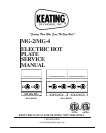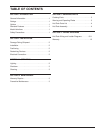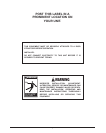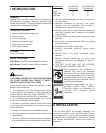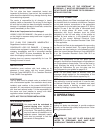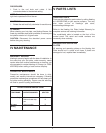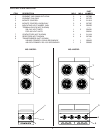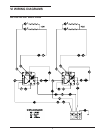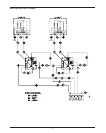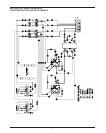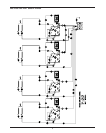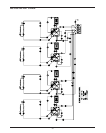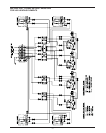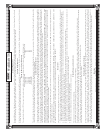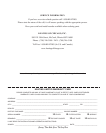
2
DAMAGE DURING SHIPMENT
The hot plate has been assembled, tested and
inspected at the factory. Upon arrival, the complete hot
plate should be checked for any damage that may have
occurred during shipment.
The carrier is responsible for all damage in transit
whether visible or concealed. Do not pay for the freight
bill until the hot plate has been thoroughly checked for
damage. If concealed damage is found later, contact the
carrier immediately to file a claim.
What to do if equipment arrives damaged:
VISIBLE LOSS OR DAMAGE – Be certain to note this
on the freight or express receipt and have it signed by
the delivery person.
FILE CLAIM FOR DAMAGES IMMEDIATELY –
Regardless of extent of damage.
CONCEALED LOSS OR DAMAGE – If damage is
noticed when equipment is unpacked, notify the freight
company immediately, and file a “concealed damage
claim”. This MUST be done immediately. Be sure to
retain the shipping container for inspection.
Keating does not assume responsibility for Loss OR
Damage incurred in transit.
INSTALLATION
Installation must conform with local codes or, in
absence of local codes, with the current National
Electrical Code ANSI/NFPA 70 or Canadian Electrical
Code CAN22.2 as applicable.
POSITIONING
The hot plate must be placed under an exhaust hood
with a fire retardant system. Your ventilation hood, when
installed, must conform to the current ANSI/NFPA 96
standard. ALL connections and placement must comply
with local and national codes. It is the responsibility of
the owner and local installer to comply with these
regulations when installing the hot plate.
NOTE: NOT FOR OUTDOOR INSTALLATION
RESTRAINING DEVICES
Hot plates must be restrained to
prevent tipping when installed in
order to avoid splashing, spilling, etc.
of hot liquid. The restraining method
may be a manner of installation or by
separate means. Adequate means
must also be provided to limit the
movement of the appliance.
IF DISCONNECTION OF THE RESTRAINT IS
NECESSARY, IT MUST BE RECONNECTED WHEN
THE HOT PLATE IS RETURNED TO ITS ORIGINALLY
INSTALLED POSITION.
ELECTRICAL CONNECTION
The Keating Electric Hot Plate is equipped with a three
wire terminal block for customer connections. Compare
the hot plate terminal connections to the appropriate
wiring diagram for the hot plate (see pages 5-11 Wiring
Diagram) to see if the hot plate is connected three
phase or single phase. All wires, cords, plugs,
receptacles and circuit breakers must be sized
adequately for the full load rating of the griddle as
specified by local codes or, in the absence of local
codes, by the current National Electrical Code
ANSI/NFPA 70 or the Canadian Electrical Code CAN
22.2 as applicable.
The Electric Hot Plate is also equipped with a grounding
lug next to the terminal block. For proper grounding
procedures, see local codes or, in the absence of local
codes, the current National Electrical Code ANSI/NFPA
70 or the Canadian Electrical Code CAN 22.2 as
applicable.
NOTE: The connections to the hot plate can be
changed in the field from three phase to single phase or
from single phase to three phase. This can be done by
simply changing the wiring at the terminal block. To
change the connections for your hot plate, see the
wiring diagram for your griddle on pages 5-11.
NOTE: For hot plates rated at 208-240 volts, the
amperage ratings marked on the nameplates of the
griddles are listed at 240 volts as required by UL.
NOTE: A hole has been punched in the rear of the hot
plate cabinet for a cord or conduit exit. If a cord is used,
the National Electrical Code, UL standards and most
local codes require a bushing or strain relief (not
provided by Keating) to protect the cord.
III OPERATING
LIGHTING
Keating hot plates are designed to provide maximum
efficiency and deliver high quality food products. Follow
lighting procedure below.
WARNING
OPERATION OF THIS HOT PLATE SHOULD BE
LIMITED TO PERSONNEL WHO HAVE BEEN
THOROUGHLY TRAINED IN OPERATING
WARNING
Do not stand, sit or
lean on equipment.



